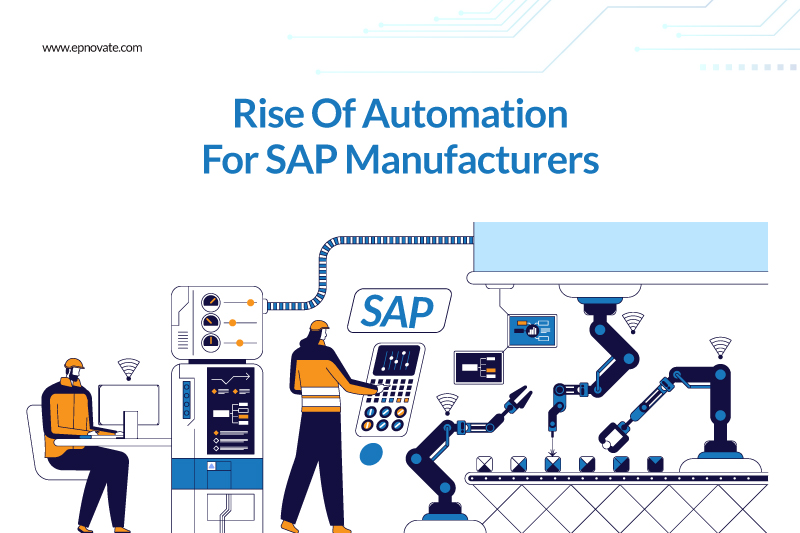Rise Of Automation For SAP Manufacturers

Manufacturing companies are being compelled by the current state of the world economy to employ cutting-edge automation technologies like AI and machine learning in order to increase productivity and flexibility in the production process. RPA and AI combined can hasten digital transformation and have a major influence on fundamental manufacturing processes, which directly impacts business KPIs. Bot-driven automation has changed factory floors, the quality of finished products, jobs, and the sector’s economics. This blog post will explain how SAP production is becoming more automated and its importance.
Manufacturing Automation And SAP Support
Businesses use manufacturing automation to increase productivity, cut costs, and improve efficiency. Fixed, programmable, and flexible automation are the three types available. SAP provides products, including SAP Digital Manufacturing Cloud, SAP Manufacturing Execution, and SAP S/4HANA Manufacturing, to support manufacturing automation initiatives. These systems offer centralized workflows, automatic data collecting, improved digital collaboration, and operational visibility that is almost real-time.
Features Of Automation In Manufacturing
- Automatic data collection, collation, and real-time reporting improve supply chain accuracy and efficiency. Using robot-assisted shipment guarantees accurate lead-time reporting and order delivery status.
- By offering quick price quotations, enhancing self-service with intelligent chatbots, and automating sales order administration, automation streamlines client contact across channels. Additionally, it gathers, compiles, and links digital media interactions and customer data with the help of SAP implementation service.
- By eliminating errors, boosting compliance by automating registration with regulatory authorities, and eradicating version control delays, automation streamlines the management of products and services. As a result, master data integration is streamlined, and errors are removed.
- Production management is streamlined through automation, which makes real-time stock movement transparent through POs and PRs. Additionally, it streamlines BOM management, making it simpler to share technical drawings and change plant materials and production methods.
- Automate monotonous operations, give expert workers more authority and handle service desk queries, IT problems, and invoice processing to make time for tasks that bring value.
Benefits Of SAP Manufacturing Automation
By boosting production, lowering labor expenses, minimizing labor shortages, and getting rid of repetitive manual and clerical duties, automation helps manufacturers in so many ways. Minimizing employee involvement and supervisory responsibilities also increases worker safety. Automation increases output, product quality, and lead times while decreasing defects and increasing productivity. Additionally, it shortens the manufacturing lead time, giving future orders a competitive advantage. The lack of trained workers leads to automated procedures that have been developed to take the place of manual labor. In general, automation of SAP upgrade services is essential for improving the competitiveness and productivity of manufacturing sectors.
Rising Trends Of Automation For SAP Manufacturers
Utilizing Robots And Machines
Robots are used on the assembly line or in warehouses to replace human work, ensure employee safety, and run a 24/7 business. They are becoming a crucial part of warehouse architecture due to the rise in e-commerce. For instance, the warehouse size will depend on the type of automation employed and the volume. Similar to how picking will depend on robotics, so will flow pathways.
Social Responsibility And Sustainability
FORCAM explains how customers are reaching their automation and sustainability goals, which are important initiatives for multinational corporations. Companies can identify possible energy savings and determine their carbon footprint by gathering information on energy consumption and its attribution to specific products. This openness makes monitoring optimization efforts and how they affect revenue easier. Brownfield machines that are 20 to 30 years old must be integrated for a complete data picture.
Data Analytics And Forecasts
Manufacturers must keep their assembly line equipment in good working order to prevent large revenue losses. According to an EY report, oil and gas businesses suffer yearly losses of between 38 million and 88 million dollars due to an average of 27 days of unscheduled downtime. Predictive maintenance benefits include cost savings, reduced downtime, improved safety, better maintenance scheduling, and a higher technical understanding of equipment relationships and interactions.
Conclusion
The manufacturing sector is seeing an increase in automation, which connects systems, applications, and software to operate together seamlessly. Personal robots take on repetitive duties, freeing up workers to perform higher-value labor. Manufacturers can use SAP upgrade services and AI delivery to use their current productivity potential better. A digitized, real-time factory and an industry-wide technology push are greatly aided by automation.
Recent Posts
- 10 SAP Line of Business Solutions Empowering Digitally Transformed Enterprise Operations
- Choosing the Right SAP Implementation Partner: What Businesses Need to Know
- How to Future-Proof Your SAP ERP
- SAP Operations Continuity: 5 Priorities You Need to Embrace Today
- Introducing The First-of-Its-Kind SAP HANA Community Cloud






